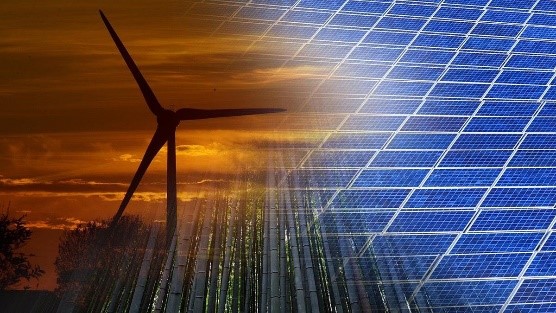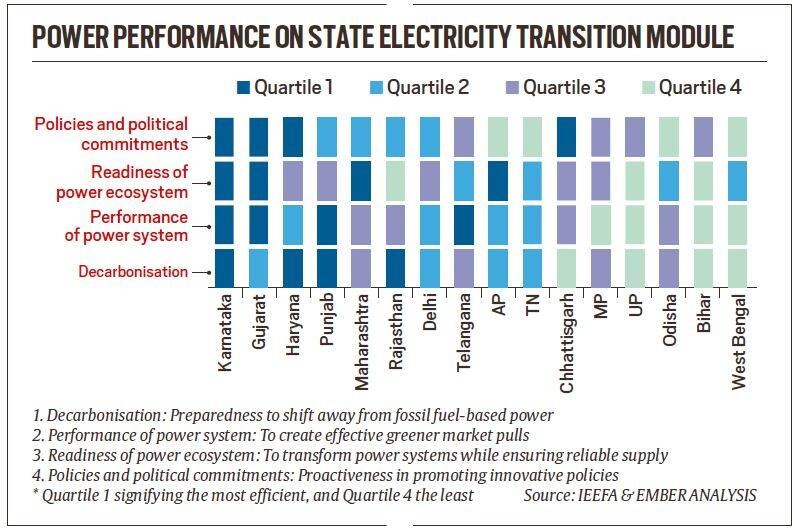Description

Disclaimer: Copyright infringement not intended.
Context
- Karnataka and Gujarat made the most progress in the transition to clean electricity - According to the ‘Indian States’ Energy Transition’ Report.
The Report
- The report — ‘Indian States’ Energy Transition’ — is prepared by the Institute for Energy Economics and Financial Analysis (IEEFA) along with EMBER.
- The report has analysed 16 states, which together account for 90% of India’s annual power requirement.
- The analysis has tracked four dimensions as mentioned in the following image:

- Based on this analysis, the report devises a scoring system — States’ Electricity Transition, or SET — which measures performance of different states in the transition to clean electricity.
Findings of the Report
Karnataka
- Karnataka is the only state among the 1 analyzed that scored well across all four dimensions of clean electricity transition identified in this study. It also has conducive policies and political commitments for a smoother transition, the study noted.
- Karnataka has been an early adopter of renewable energy through proactive policies around open access, solar park development and public awareness. The state fared the best in decarbonizing its power sector and has the highest share of renewables in its power supply mix (48%).
- Karnataka currently is one of the few states overachieving its Renewable Purchase Obligations targets.
- The state still has a large amount of untapped renewable energy potential, having installed just 11% of its total potential, the report noted. This highlights the state’s tremendous opportunity to provide power to neighbouring states through green market mechanisms
.jpeg)
Rajasthan
- Rajasthan is second only to Karnataka, with renewables supplying 29% of the state’s power mix. It saw a spurt in new renewable energy capacity and, in March 2022, became the state with the largest installed capacity of renewable energy.
Gujarat
- Gujarat was a little behind Karnataka in terms of decarbonising its electricity sector.
Haryana and Punjab
- Haryana and Punjab have shown promising preparations and implementations for electricity transition, the report stated.
- Punjab turned about a quarter of its renewable energy potential into installed capacity (1.8GW), and targets to install solar PV (Photovoltaic) projects with a total capacity of 300 MW.
- Haryana has the lowest installed capacity of older, more polluting coal power plants. As of the study period, it only had about 210 MW coal power capacity older than 25 years, which is much lower than the numbers in other states.

Maharashtra
- Maharashtra, with the highest power demand in India, was found to be mid-table, mainly due to slow renewable energy uptake in the state and the inability to shut down older polluting coal power plants. Its renewable energy share (11%) is lower than most other states.
Bihar, UP, and West Bengal
- Bihar, UP, and West Bengal have work to do to strengthen their clean electricity transition performances. These states should maximize their renewable energy generation potential, and at the same time increase commitment to moving away from fossil fuel-based electricity.
|
INSTITUTE FOR ENERGY ECONOMICS AND FINANCIAL ANALYSIS (IEEFA)
The Institute for Energy Economics and Financial Analysis is a U.S. non-profit corporation. The Institute for Energy Economics and Financial Analysis (IEEFA) examines issues related to energy markets, trends, and policies. The Institute's mission is to accelerate the transition to a diverse, sustainable, and profitable energy economy.
EMBER
Ember, formerly Sandbag or Sandbag Climate Campaign, is an environmental non-profit think tank, campaigning to reduce the use of coal. Based in the UK, the organisation was launched in 2008.
|
|
PRACTICE QUESTION
Q) Which of the following statements is/are correct?
a. The report — ‘Indian States’ Energy Transition’ — is prepared by the United Nations Environment Program (UNEP) along with INSEAD.
b. Karnataka currently is one of the few states overachieving its Renewable Purchase Obligations targets.
I. Only a
II. Only b
III. Both a and b
IV. Neither a nor b
Answer: Option II
|

Read:https://www.iasgyan.in/daily-current-affairs/renewable-energy-in-india-15#:~:text=What%20Is%20Renewable%20Energy%3F,depends%20on%20time%20and%20weather.
https://indianexpress.com/article/india/karnataka-best-performing-state-in-clean-energy-transition-report-8471350/














